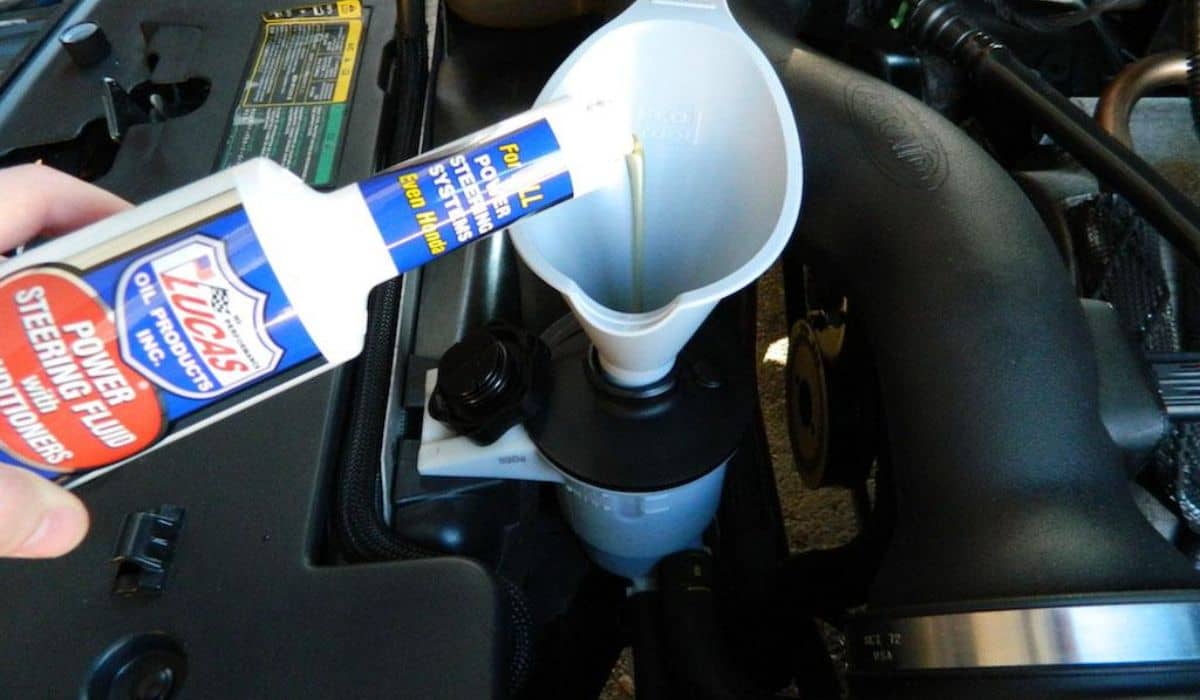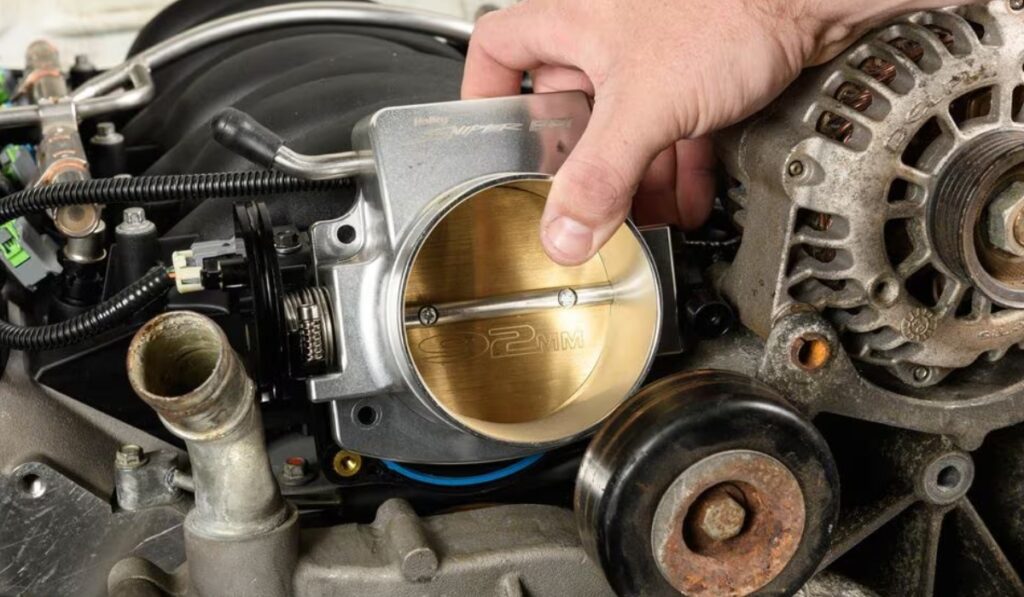Transmission and power steering fluid overview
Transmission Fluid
Transmission fluid is a lubricant designed for car transmissions. Lubricating gears, bearings, and clutches in automatic and manual gearboxes is essential.
Heat dissipation, hydraulic pressure regulation, and friction reduction depend on gearbox fluid. It is usually made using base oils and additives customised to gearbox designs and operating conditions. Transmission fluid is red or pink for identification.
Power Steering Fluid
Hydraulic power steering fluid aids steering mechanics. It transmits force from the steering wheel to the steering mechanism, making vehicle manoeuvrability and control easier.
Hydraulic oils and additives in power steering fluid lubricate, anti-wear, and prevent corrosion. Power steering fluid is amber or clear for visual inspection, unlike gearbox fluid.
The importance of using correct vehicle fluid type
Using the right automotive fluid is crucial for various reasons:
1. Optimal Performance:
Vehicle manufacturers recommend fluids for each system for optimal performance and lifetime. Maintaining adequate lubrication, heat dissipation, and hydraulic pressure requires the right fluid.
Not following manufacturer instructions can reduce performance, wear, and system failure.
2. Damage Protection:
Each fluid is designed to meet its system’s needs. Misusing gearbox fluid in power steering or vice versa can cause problems.
Transmission fluid in the power steering system may not lubricate well, causing steering component wear and damage. Power steering fluid in the gearbox system may not meet lubrication standards, causing friction and gearbox failure.
3. Warranty Compliance:
Vehicle warranties often need specific fluids for maintenance and repairs. Failure to use recommended fluids might void the warranty, leaving the vehicle owner liable for any repairs.
4. Road safety depends on using the right fluid in a vehicle. Power steering systems that lack hydraulic pressure and lubrication may lose control, making vehicle navigation harder, especially in crucial conditions.
Lack of lubrication and heat dissipation in gearbox systems can cause poor shifting, slippage, or failure, endangering the driver and passengers.
The Similarities Between the Two Fluids
| Transmission Fluid | Power Steering Fluid | |
|---|---|---|
| Composition | Specially formulated mix of base oils and additives | Variety of formulations, including hydraulic oils and synthetic fluids |
| Function | Lubricates gears, bearings, and other moving parts in the transmission | Hydraulic fluid that transfers force from the steering wheel to the steering mechanism |
| Characteristics | Higher viscosity and friction modifiers to meet the demands of the transmission | Lower viscosity and additives to handle the high-pressure demands of power steering systems |
| Color | Usually red or pink in color | Usually amber or clear in color |
| Requirements | Various specifications based on the type of transmission (manual or automatic) | Various specifications based on the type of power steering system (hydraulic or electric) |
| Compatibility | May not be compatible with power steering systems and can cause damage if used incorrectly | May not provide adequate lubrication for transmission components and can lead to system failure |
| Manufacturer Recommendations | Vehicle manufacturers provide specific fluid recommendations in the owner's manual | Vehicle manufacturers provide specific fluid recommendations in the owner's manual |
The Differences That Matter
| Transmission Fluid | Power Steering Fluid | |
|---|---|---|
| Hydraulic Fluid | Both are types of hydraulic fluids, using fluid pressure to transfer power | Both are types of hydraulic fluids, using fluid pressure to assist in steering mechanics |
| Lubrication | Both fluids provide lubrication to reduce friction and wear within their respective systems | Both fluids provide lubrication to reduce friction and wear within the power steering system |
| Heat Dissipation | Both fluids aid in dissipating heat generated during operation | Both fluids help regulate temperature and prevent overheating within their systems |
| Chemical Composition | Both fluids are composed of base oils and additives | Both fluids have similar chemical composition with additives for enhanced performance |
Potential Issues When Mixing the Fluids:
Here’s where things get dicey. If you were to use transmission fluid in a power steering system not designed for it, several issues could arise:
• Incompatibility with Seals:
The different additive packages can cause the seals in the power steering system to deteriorate or leak. Leaks are not only messy but can also lead to costly repairs.
• Performance Issues:
Incorrect fluid can impact the system’s performance. You might experience harder steering or notice odd noises when turning the wheel.
• Long-term Damage:
Over time, using the wrong fluid can cause wear and tear on the power steering pump and other components, leading to expensive replacements. If you’re wondering how to tell if a power steering pump is bad, keep an eye out for symptoms such as unusual noises, difficulty turning the steering wheel, or fluid leaks. Proper maintenance and using the correct fluid are essential to prevent these issues.
It’s not just about a quick fix; it’s about ensuring the longevity and optimal performance of your vehicle’s systems.
Checking Manufacturer Recommendations
Always, and this can’t be stressed enough, refer to your vehicle’s owner’s manual or consult with the manufacturer. As mentioned earlier, some vehicles are designed to run on ATF in their power steering systems.
However, many are not. By checking the manual, you get definitive information tailored for your specific vehicle model.
Making assumptions or going by hearsay can lead to expensive mistakes. It’s always better to spend a few minutes with your manual than hours (and dollars) at the repair shop.
When In Doubt, Consult a Professional
If you’re uncertain on Can you use transmission fluid for power steering fluid, or if you’ve mistakenly added the wrong fluid, it’s best to seek professional help.
Mechanics have the knowledge and equipment to flush out the incorrect fluid and replace it with the right one. They can also inspect the system for potential damages or issues that might have arisen due to the fluid mix-up.
Your car is an investment. Entrusting its care to professionals ensures it stays in peak condition and serves you well for years to come.
FAQ
1. Can gearbox fluid replace power steering fluid in any vehicle?
Gearbox fluid cannot replace power steering fluid. Many vehicle manufacturers do not allow ATF (automatic gearbox fluid) in power steering systems.
The wrong fluid can cause performance concerns, long-term component damage, and vehicle health issues. You should examine your vehicle’s owner’s handbook or receive professional guidance before making such selections.
2. What are gearbox and power steering fluids’ main functions?
Mostly, gearbox fluid lubricates the car’s gearbox. Smooth gear shifts, transmission lubrication, and heat dissipation are achieved. However, power steering fluid is a hydraulic fluid that aids vehicle power steering.
It transfers steering wheel force to the car’s steering mechanism for smoother turns. Both are essential for vehicle efficiency.
3. Are there apparent differences between gearbox and power steering fluid?
Visual differences exist. Transmission fluid is red or pink to identify. Power steering fluid is usually transparent or amber. However, brand and fluid age might affect colour. Always check the car manual or consult professionals to use the proper fluid.
4. What happens if I accidently use gearbox fluid in my power steering?
Answer: Using gearbox fluid in a power steering system not built for it can cause issues. Incompatibility with seals can cause deterioration or leakage.
Performance concerns like harsher steering or strange wheel noises can occur. Long-term wear and tear from the improper fluid could damage the power steering pump and other pricey components.
5.How can I choose a car fluid?
Check your car’s manual for the most accurate information. Manufacturers prescribe fluids for each car model. If you’ve lost the manual, visit the manufacturer’s website or a dealership.
Many cars include reservoir labels or dipsticks that indicate fluid type. To safeguard your car’s safety and performance, call a skilled mechanic or reputable vehicle service centre if you’re unsure or think you applied the wrong fluid.
While there are some overlaps between power steering fluid and transmission fluid, they aren’t always interchangeable. It’s essential to recognize the specific needs of your vehicle and address them accordingly.
By doing so, you safeguard the integrity of your vehicle, ensuring smooth rides and steering for the long haul. Remember, when in doubt, always refer back to your vehicle’s manual or seek expert advice. Your car will thank you for it!





